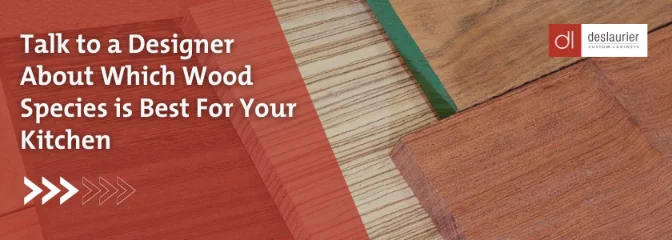22/11/2022 • Blog, Product Reviews, Comparisons
6 Best Wood Species for Stained Kitchen Cabinets
Estimated Read Time: 6 Minutes
Choosing the right wood for your kitchen cabinets often comes down to your personal aesthetic preferences. Maybe you prefer a darker wood with a wavy, eccentric grain pattern, or a lighter appearance with a straight and subtle grain.
However, there are some wood species that are better suited for stained cabinets than others. Which ones? We’re here to help narrow it down for you!
At Deslaurier, for over 40 years we’ve specialized in manufacturing and designing custom cabinets with equal parts beauty and function. In that time, we’ve installed thousands of homes with stained kitchen cabinets made from a number of different wood species.
In this article, we’ll take a look at 6 popular wood species that are perfect for stained kitchen cabinets.
Let’s get started!
|
Table of Contents |
What Makes a Stain-Grade Wood?
The most significant aesthetic indicator of stained wood cabinetry is that the wood’s natural grain pattern and texture remains visible. Stains seep into the cabinet door surface and provide a rich, translucent finish.
Stain-grade wood species can be both hardwood and softwood. Their strength and durability aren’t as important as it is for painted cabinets, which need slightly more resistance to dents and scratches to protect the painted finish.
If a stained wood cabinet collects some slight dents or dings, it’s often quite hard to notice. In fact, softer woods can be emphasized with a worn or distressed appearance as well. Any subtle damage to the door can actually add to the appearance!
Of course, we don’t recommend intentionally damaging your cabinet doors! We mention that just to highlight the difference between stained and painted cabinet woods.
An important quality for stain-grade woods is that they are generally nonporous—meaning their “pores” are very small and tight, making it difficult for any liquid to flow through them.
Conversely, porous woods have larger pores that will absorb stains almost too well. This can cause the stain to fluctuate throughout the wood and result in a blotchy appearance.
For example, a wood like poplar is extremely porous and will absorb a stain so thoroughly that it will result in random blotchiness throughout the finished product. Even a popularly used wood like birch, which is only slightly porous, can still be somewhat unpredictable when adorned with a darker stain.
This is where something like wood veneer will benefit you!
Staining Wood Veneer Cabinets
Wood veneer cabinets provide the look and texture of natural wood at a reduced cost. That’s because wood veneer cabinets are actually made of real wood!
To create wood veneer, a thin sheet of real wood is adhered to an underlying substrate. While some manufacturers may use plywood for a substrate, wood veneer is most commonly applied to particleboard; the same material that cabinet boxes are made out of.
Wood veneer is offered in many of the same species as solid wood cabinets, so there is a wide variety of wood grains and species to choose from.
Wood veneer won’t have as blotchy or uneven appearance when stained as solid wood might, simply because the particleboard substrate is so thick relative to the veneer sheet.
The thin surface sheet of wood veneer means the stain won’t seep through the depth of the door, resulting in a far more consistent appearance. The slightly porous tendencies of solid birch, then, can be nullified by using wood veneer.
The fact that wood veneer will also save you money in the process is just an added bonus!
It should be noted that if you go with wood veneer cabinets you won’t be able to have a worn or distressed cabinet aesthetic. Those cabinet styles require solid wood doors, as wood veneer sheets are too thin to achieve that appearance without exposing the underlying material.
1. Stained Maple Cabinets
Maple truly is one of the most versatile woods available for kitchen cabinets. Its smooth, uniform surface offers the perfect canvas for a painted finish. While its natural grain pattern and colouring can be accentuated underneath anything from a light to dark stain.
Maple’s grain pattern is generally quite straight, with some subtle waves and curls mixed in, while its colour is rooted in a gentle white with reddish-brown hues.
Maple shares a lot of similar qualities with birchwood. After all, they’re both considered two of the best paint-grade wood species you can find for kitchen cabinets!
However, unlike birch, maple is entirely nonporous! In that sense, you shouldn’t worry about any pronounced blotchiness when a darker, heavier stain adheres to maple cabinets.
2. Stained Oak Cabinets
Red oak (commonly referred to simply as “oak”) is noted for having light to middle brown colouring with a cast of reddish hues; complemented by a prominent, fairly straight grain pattern.
The beauty of red oak and its prominent grain is that it can look great in anything from a clear coat finish to a dark stain. Oak’s natural patterning will emerge through anything and offer a textured, tactical cabinet that most other woods can’t replicate.
While oak often has the connotation of being a more traditional-looking cabinet wood, there are plenty of ways you can put a modern flair on oak cabinets! Going with a contemporary white oak selection is a great way to do just that!
White oak is overall much lighter than red oak, while still carrying slight pink and purple hues, and also sports a smoother surface.
When talking about white oak, it’s important to mention the popular rift-cut variety. Rift-sawing wood is purely aesthetic and achieves a straight grain pattern that cuts down on shiny spots in the grain known as flakes. It is most commonly used with oak because its wood grain is generally the straightest and free from cathedrals or variations
White oak is never painted and is almost exclusively accompanied by subtle, gentle stains. This ensures that the light, natural colouring it’s known for will emerge triumphantly and remain prominently on display.
3. Stained Walnut Cabinets
Walnut is a stunning natural wood noted for its significant colour and strong, typically straight grain variation. Though its grain is very open and slightly coarser than the smoothness of cherry, walnut still has a beautiful, uniform surface.
Walnut can range anywhere from a light brown to a deep, dark chocolate hue. In addition, it also has a unique aging process. With time, the dark brown colour of walnut naturally begins to lighten.
The qualities of walnut lend themself beautifully to light stains and clear coat finishes. When finished with a clear topcoat, walnut portrays a very rich and velvety sheen that accentuates its strong grain pattern.
4. Stained Cherry Cabinets
Cherry wood is prized for its aesthetic and is often associated with more of a traditional look. Noted for its rich, dark, reddish-brown colour and smooth, closed-grain pattern – perfect for stain application – cherry is one of the most luxurious woods you can find for your kitchen cabinets.
A key characteristic to note about cherry wood is its natural aging process. Starting almost as a light or golden pink, cherry gradually gains deep, alluring reddish-brown hues as it is exposed to oxidation and natural lighting over time.
What might be surprising about cherry wood cabinets is that you’re actually less likely to apply a darker stain to them (unless that is your preference). Since cherry wood naturally gets darker with time, it doesn’t require a deep, heavy stain like some other woods might.
Rather, thanks in part to cherry’s aging process, most people use a clear coat finish or gentle stain to enhance the rich, natural colour and grain pattern of cherry wood.
5. Stained Mahogany Cabinets
For centuries, mahogany has been popularly utilized all over the house from kitchen tables and chairs to office desks and bookcases.
Mahogany is renowned for its straight grain pattern and illustrious reddish-brown colouring that ranges in a variety of different shades.
Mahogany and traditional kitchen design might go hand-in-hand better than any other material. The wood’s rich colour lends itself beautifully to ornate cabinet door styles and decorative crown mouldings.
6. Stained Pine Cabinets
Pinewood cabinets are a beautiful and classic choice for any kitchen. Unlike the other wood species on this list – which are all hardwoods – pine is actually a softwood – but a strong one at that!
Because of this, pinewood has a soft texture and smooth grain. Pine is also noted for its gentle colour, ranging from light yellowish-white to a soft reddish-white. Thanks to this versatility, pinewood cabinets work well in anything from a traditional kitchen to a more modern design.
At Deslaurier, we sell a common variety of pine known as “knotty” pine. Knotty pine features random knots throughout the wood which may be as large as 3" in diameter. Smaller pin-sized knots will also be found scattered throughout the face of the door.
The characteristics of knotty pine are enhanced beautifully with a prominent stain or glaze. With specific areas of its grain pattern being highlighted with darker stains.
Design with Deslaurier Custom Cabinets
If you’re looking for the perfect stained cabinets for your kitchen, Deslaurier Custom Cabinets has a selection that will fit your needs!
Deslaurier proudly carries several of the stain-grade wood species listed above in our extensive product catalogue. Add to that our collection of over 70+ cabinet door styles – and over 40+ cabinet stains as well as the ability to custom colour match – there’s no doubt we have a cabinet for every design style.
Book a consultation today with a Deslaurier design expert at our Ottawa Showroom or schedule a virtual meeting! With over 40 years of experience to our name, we provide our clients with a fully customized design process with our talented team of designers.
Interested in becoming an authorized Deslaurier dealer? Visit our Become a Dealer page to learn more! Live outside the area? Visit our Find a Dealer page to connect with a Deslaurier dealer near you!
.png?width=224&height=80&name=Final%20(3).png)



